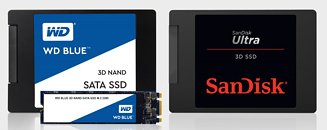Raevenlord
News Editor
- Joined
- Aug 12, 2016
- Messages
- 3,755 (1.15/day)
- Location
- Portugal
| System Name | The Ryzening |
|---|---|
| Processor | AMD Ryzen 9 5900X |
| Motherboard | MSI X570 MAG TOMAHAWK |
| Cooling | Lian Li Galahad 360mm AIO |
| Memory | 32 GB G.Skill Trident Z F4-3733 (4x 8 GB) |
| Video Card(s) | Gigabyte RTX 3070 Ti |
| Storage | Boot: Transcend MTE220S 2TB, Kintson A2000 1TB, Seagate Firewolf Pro 14 TB |
| Display(s) | Acer Nitro VG270UP (1440p 144 Hz IPS) |
| Case | Lian Li O11DX Dynamic White |
| Audio Device(s) | iFi Audio Zen DAC |
| Power Supply | Seasonic Focus+ 750 W |
| Mouse | Cooler Master Masterkeys Lite L |
| Keyboard | Cooler Master Masterkeys Lite L |
| Software | Windows 10 x64 |
Western Digital and SanDisk have updated their Blue and Ultra line of consumer SSDs with the latest 3D BiCS FLASH NAND technology. Capacities will range from 250 GB capacities through 500 GB and up to 1TB at launch, with a 2 TB SanDisk Ultra 3D SSD "coming soon." The hardware powering each drive is exactly the same, save for the difference in available storage: the controller used is a Marvell 88SS1074, protocol is SATA 6Gbps / AHCI, and even warranty stays the same through all WD and SanDisk models, at three-years (limited.)
The WD Blue line of SSDs will be available in both 2.5" and M.2 2280 single-sided models. Sequential read speed starts at 550 MB/s for both WD Blue 250 GB and SanDisk Ultra 3D, with sequential write speeds at a rated 525 MB/s and read/write IOPS being set at 95,000/81,000 respectively. All other (higher) capacities deliver slightly more performance: 560 MB/s sequential read speeds, 530 MB/s sequential writes, 95,000 random read IOPS, and 84,000 random write IOPS. Pricing is as follows: WD Blue 3D 250 GB ($89); Blue 3D 500 GB ($149.99), Blue 3D 1 TB ($279.99); SanDisk Ultra 3D 250 GB ($99.99), Ultra 3D 500 GB ($164.99), Ultra 3D 1TB ($279.99) and Ultra 3D 2TB ($549.99, currently unavailable.)

View at TechPowerUp Main Site
The WD Blue line of SSDs will be available in both 2.5" and M.2 2280 single-sided models. Sequential read speed starts at 550 MB/s for both WD Blue 250 GB and SanDisk Ultra 3D, with sequential write speeds at a rated 525 MB/s and read/write IOPS being set at 95,000/81,000 respectively. All other (higher) capacities deliver slightly more performance: 560 MB/s sequential read speeds, 530 MB/s sequential writes, 95,000 random read IOPS, and 84,000 random write IOPS. Pricing is as follows: WD Blue 3D 250 GB ($89); Blue 3D 500 GB ($149.99), Blue 3D 1 TB ($279.99); SanDisk Ultra 3D 250 GB ($99.99), Ultra 3D 500 GB ($164.99), Ultra 3D 1TB ($279.99) and Ultra 3D 2TB ($549.99, currently unavailable.)

View at TechPowerUp Main Site




